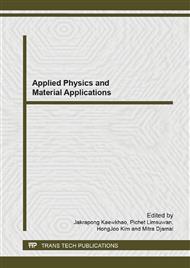p.104
p.108
p.112
p.116
p.120
p.124
p.128
p.132
p.136
Effects of Precursor Concentration on Hexagonal Structures of ZnO Nanorods Grown by Aqueous Solution Method
Abstract:
The ZnO nanorods were fabricated on top of the seeded gold layer by the aqueous solution method with the solution of zinc nitrate and hexamethylenetetramine (HTMA) at 90°C for 24 hours. The variety of the ZnO nanorods were prepared and investigated based on the precursor concentrations, in a range of 1 to 40 mM. The physical morphologies and crystal structures were characterized by field-emission scanning electron microscopy (FE-SEM) and X-ray diffractometry (XRD), respectively. The results showed that, with the small precursor concentrations, the lateral growth of the nanorods was highly significant when compared to their axial growth. The precursor concentration of 20 mM was best optimized for the preparation of the ZnO nanorod arrays with the hexagonal structures at the highest rod diameter and length. At the higher concentrations, although the nanorod size remained nearly constant, the length was however rapidly decreased. Further analyses also proved that, with the increased precursor concentrations, the number density of the ZnO nanorods was progressively increased along with the more complete hexagonal wurtzite structures.
Info:
Periodical:
Pages:
120-123
Citation:
Online since:
September 2013
Price:
Сopyright:
© 2013 Trans Tech Publications Ltd. All Rights Reserved
Share:
Citation:


